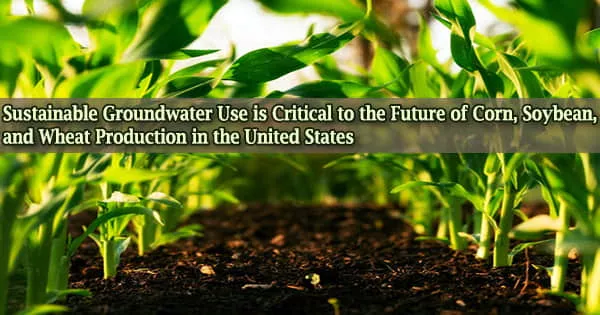Corn, soybeans, and winter wheat account for 52 percent of irrigated acreage in the United States. Maize and soybeans are two of the country’s most important crops, with irrigated areas accounting for 17 percent of corn production and 12 percent of soybean production.
However, the water utilized for irrigation is frequently pumped groundwater, which is not sustainable. According to a study published in Earth’s Future by Dartmouth, using groundwater sustainably for agriculture in the United States might drastically cut corn, soybean, and winter wheat production. Irrigation is dependent on groundwater extraction from aquifers, which also serve as a supply of drinking water and are vital to lakes, rivers, and ecosystems.
Rainfall, snowmelt, and other water permeate the soil and gather in a permeable layer underground, replenishing aquifers. However, if groundwater consumption exceeds aquifer recharge rates, the amount of groundwater accessible in the aquifer, including for producing crops, is reduced.
“Our findings underscore how corn, soybean, and winter wheat production could be affected if we chose to stop depleting aquifers across the United States,” says co-lead author Jonathan Winter, an associate professor of geography and principal investigator of the Applied Hydroclimatology Group at Dartmouth.
“However, future precipitation, which affects groundwater resources, is difficult to predict, and improved irrigation technology, more water-efficient crops, and better agricultural water management could reduce the production losses from a transition to sustainable groundwater use.”
Researchers used a crop model to replicate irrigated agriculture from 2008 to 2012 to examine the effects of sustainable groundwater use for irrigated maize, soybeans, and winter wheat. The crop model was validated by comparing survey data from the United States Department of Agriculture to daily weather, soil attributes, farm management, and crop varieties.
Crop production was modeled using four distinct groundwater use scenarios, ranging from the most optimistic to the most pessimistic. In the most hopeful case, the maximum quantity of recharge is available for irrigation.
Sustainable groundwater use is critical to maintaining irrigated agricultural production, especially in a global food system that is already taxed by climate change, population growth, and shifting dietary demands.
Jose R. Lopez
The less optimistic scenarios, which are based on safe aquifer yield, imply that only a small portion of the recharge is absorbed by the aquifer and that only a little amount of water is available for irrigation.
The less optimistic scenarios account for groundwater resource uncertainty as well as the need to conserve some water in order to sustain healthy ecosystems. The four sustainable groundwater usage scenarios are based on 100 percent, 75 percent, 50 percent, and 25 percent safe aquifer yields.
Corn, soybean, and winter wheat irrigated production in the United States would be cut by 20%, 6%, and 25%, respectively, under the most optimistic sustainable groundwater usage scenario. Corn, soybean, and winter wheat production are cut by 45%, 37%, and 36%, respectively, in the most pessimistic scenario.
“Our findings underscore how corn, soybean, and winter wheat production could be affected if we chose to stop depleting aquifers across the United States,” says co-lead author Jonathan Winter, an associate professor of geography and principal investigator of the Applied Hydroclimatology Group at Dartmouth.
“However, future precipitation, which affects groundwater resources, is difficult to predict, and improved irrigation technology, more water-efficient crops, and better agricultural water management could reduce the production losses from a transition to sustainable groundwater use.”
The findings suggest that Nebraska, Kansas, and Texas, which rely on groundwater from the High Plains Aquifer (also known as the Ogallala Aquifer) to grow maize, soybeans, and winter wheat, would suffer the biggest output losses if sustainable groundwater usage were implemented.
The paucity of rainfall in this area makes it particularly vulnerable, limiting rainfed agriculture and groundwater recharging. According to a previous study, the High Plains draws three times more groundwater than its aquifer recharge rate.
Sustainable groundwater use would result in large production losses in corn and winter wheat in Central California, which relies on the Central Valley Aquifer. However, production losses in corn and winter wheat in California are limited due to the dominance of specialty crops such as almonds, grapes, and lettuce, which limit the amount of land used to grow corn and winter wheat.
In contrast, because groundwater extraction is often less than recharge in the Mississippi Valley, which is major maize and soybean producing region, there would be very minor production losses.
Because the Midwest is humid and relies primarily on rain-fed rather than irrigated agriculture, there would be modest losses in maize and soybean production.
“Sustainable groundwater use is critical to maintaining irrigated agricultural production, especially in a global food system that is already taxed by climate change, population growth, and shifting dietary demands,” says co-lead author Jose R. Lopez, a former postdoctoral researcher in geography at Dartmouth.
“We need to expand the implementation of water conservation strategies and technologies we have now and develop more tools that can stabilize the nation’s groundwater supply while preserving crop yields and farmer livelihoods.”
















